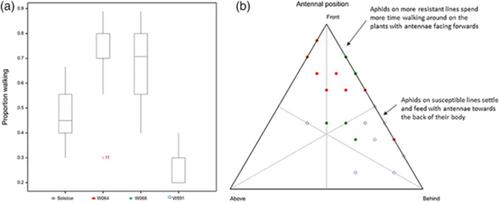当前位置:
X-MOL 学术
›
Ann. Appl. Biol.
›
论文详情
Our official English website, www.x-mol.net, welcomes your
feedback! (Note: you will need to create a separate account there.)
Characterization of bird cherry‐oat aphid ( Rhopalosiphum padi L.) behaviour and aphid host preference in relation to partially resistant and susceptible wheat landraces
Annals of Applied Biology ( IF 2.2 ) Pub Date : 2020-07-15 , DOI: 10.1111/aab.12616 Beant Singh 1 , Amma Simon 2, 3 , Kirstie Halsey 2 , Smita Kurup 2 , Suzanne Clark 2 , Gudbjorg Inga Aradottir 2
Annals of Applied Biology ( IF 2.2 ) Pub Date : 2020-07-15 , DOI: 10.1111/aab.12616 Beant Singh 1 , Amma Simon 2, 3 , Kirstie Halsey 2 , Smita Kurup 2 , Suzanne Clark 2 , Gudbjorg Inga Aradottir 2
Affiliation

|
Abstract The bird cherry‐oat aphid (Rhopalosiphum padi L.) is a major pest of wheat (Triticum aestivum L.) and can cause up to 30% yield losses. Heritable plant resistance to aphids is both an economically and ecologically sound method for managing aphids. Here we report how the behaviour and performance of R. padi differs on two resistant, one susceptible wheat landrace and a susceptible elite wheat variety. Feeding behaviour differed among the genotypes, with aphids on resistant lines spending longer in the pathway phase and less time phloem feeding. These behaviours suggest that both inter‐ and intracellular factors encountered during pathway and phloem feeding phases could be linked to the observed aphid resistance. Locomotion and antennal positioning choice tests also revealed a clear preference for susceptible lines. Although feeding studies revealed differences in the first probe indicating that the resistance factors might also be located in the peripheral layers of the plant tissue, scanning electron microscopy revealed no difference in trichrome length and density on the surface of leaves. Aphids are phloem feeders and limiting the nutrient uptake by the aphids may negatively affect their growth and development as shown here in lower weight and survival of nymphs on resistant genotypes and decreased reproductive potential, with lowest mean numbers of nymphs produced by aphids on W064 (54.8) compared to Solstice (71.9). The results indicate that resistant lines markedly alter the behaviour, reproduction and development potential of R. padi and possess both antixenosis and antibiosis type of resistance.
中文翻译:

鸟樱桃燕麦蚜 (Rhopalosiphum padi L.) 行为特征和与部分抗性和易感小麦地方品种相关的蚜虫寄主偏好
摘要 鸟樱桃燕麦蚜 (Rhopalosiphum padi L.) 是小麦 (Triticum aestivum L.) 的主要害虫,可造成高达 30% 的产量损失。植物对蚜虫的遗传抗性是一种既经济又生态的管理蚜虫的方法。在这里,我们报告了水稻根瘤菌在两种抗性、一种易感小麦地方品种和一种易感优良小麦品种上的行为和性能有何不同。不同基因型的取食行为有所不同,抗性品系上的蚜虫在途径阶段花费的时间更长,韧皮部取食的时间更少。这些行为表明,在途径和韧皮部取食阶段遇到的细胞间和细胞内因素可能与观察到的蚜虫抗性有关。运动和触角定位选择测试也显示出对易感品系的明显偏好。尽管饲喂研究揭示了第一个探针的差异,表明抗性因子也可能位于植物组织的外围层,但扫描电子显微镜显示叶子表面的三色长度和密度没有差异。蚜虫是韧皮部饲养者,限制蚜虫对养分的吸收可能会对它们的生长和发育产生负面影响,如抗性基因型若虫的重量和存活率较低以及繁殖潜力下降所示,W064 上蚜虫产生的若虫平均数量最低(54.8 )与至日(71.9)相比。结果表明,抗性品系显着改变了R. padi的行为、繁殖和发育潜力,并且具有抗异种和抗菌类型的抗性。
更新日期:2020-07-15
中文翻译:

鸟樱桃燕麦蚜 (Rhopalosiphum padi L.) 行为特征和与部分抗性和易感小麦地方品种相关的蚜虫寄主偏好
摘要 鸟樱桃燕麦蚜 (Rhopalosiphum padi L.) 是小麦 (Triticum aestivum L.) 的主要害虫,可造成高达 30% 的产量损失。植物对蚜虫的遗传抗性是一种既经济又生态的管理蚜虫的方法。在这里,我们报告了水稻根瘤菌在两种抗性、一种易感小麦地方品种和一种易感优良小麦品种上的行为和性能有何不同。不同基因型的取食行为有所不同,抗性品系上的蚜虫在途径阶段花费的时间更长,韧皮部取食的时间更少。这些行为表明,在途径和韧皮部取食阶段遇到的细胞间和细胞内因素可能与观察到的蚜虫抗性有关。运动和触角定位选择测试也显示出对易感品系的明显偏好。尽管饲喂研究揭示了第一个探针的差异,表明抗性因子也可能位于植物组织的外围层,但扫描电子显微镜显示叶子表面的三色长度和密度没有差异。蚜虫是韧皮部饲养者,限制蚜虫对养分的吸收可能会对它们的生长和发育产生负面影响,如抗性基因型若虫的重量和存活率较低以及繁殖潜力下降所示,W064 上蚜虫产生的若虫平均数量最低(54.8 )与至日(71.9)相比。结果表明,抗性品系显着改变了R. padi的行为、繁殖和发育潜力,并且具有抗异种和抗菌类型的抗性。











































 京公网安备 11010802027423号
京公网安备 11010802027423号